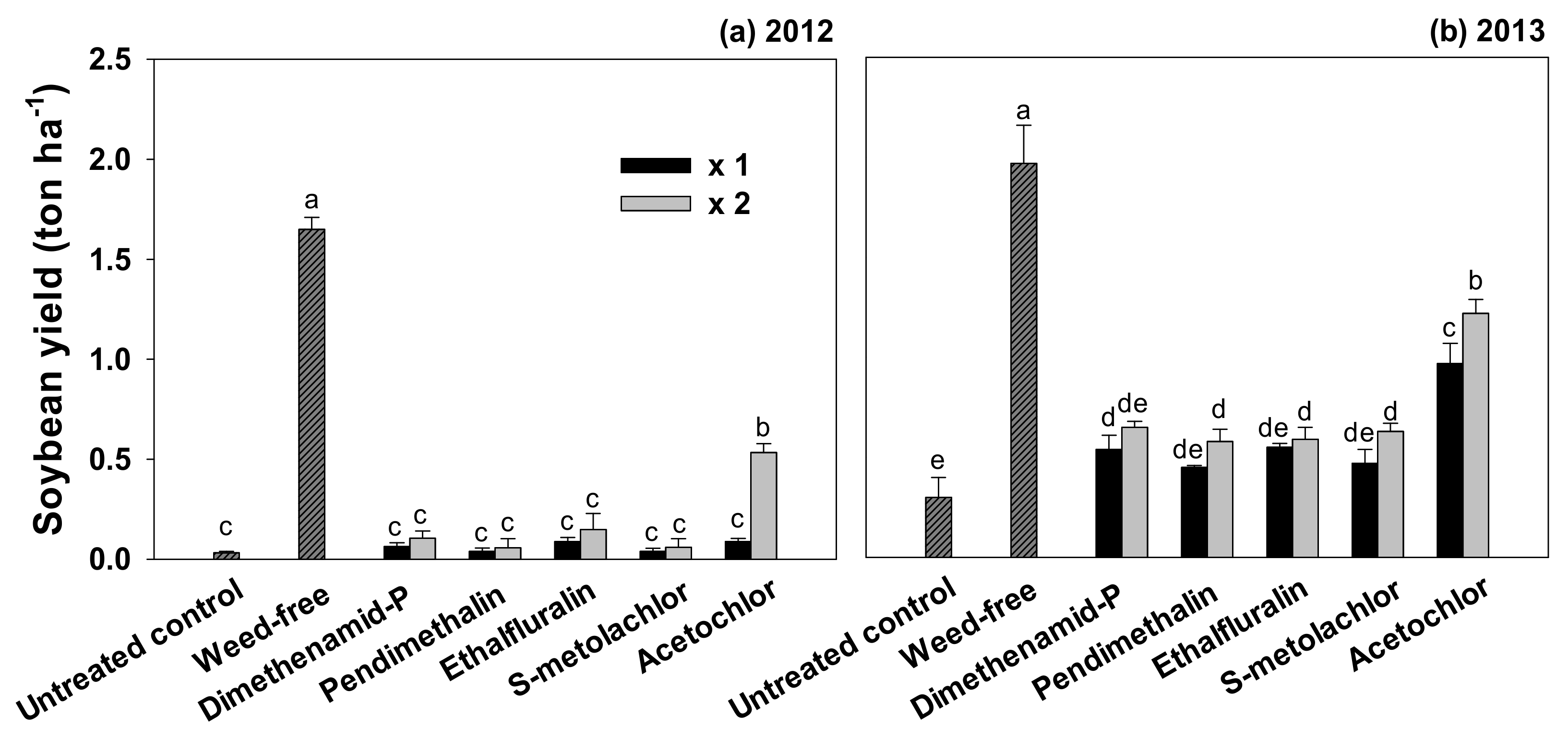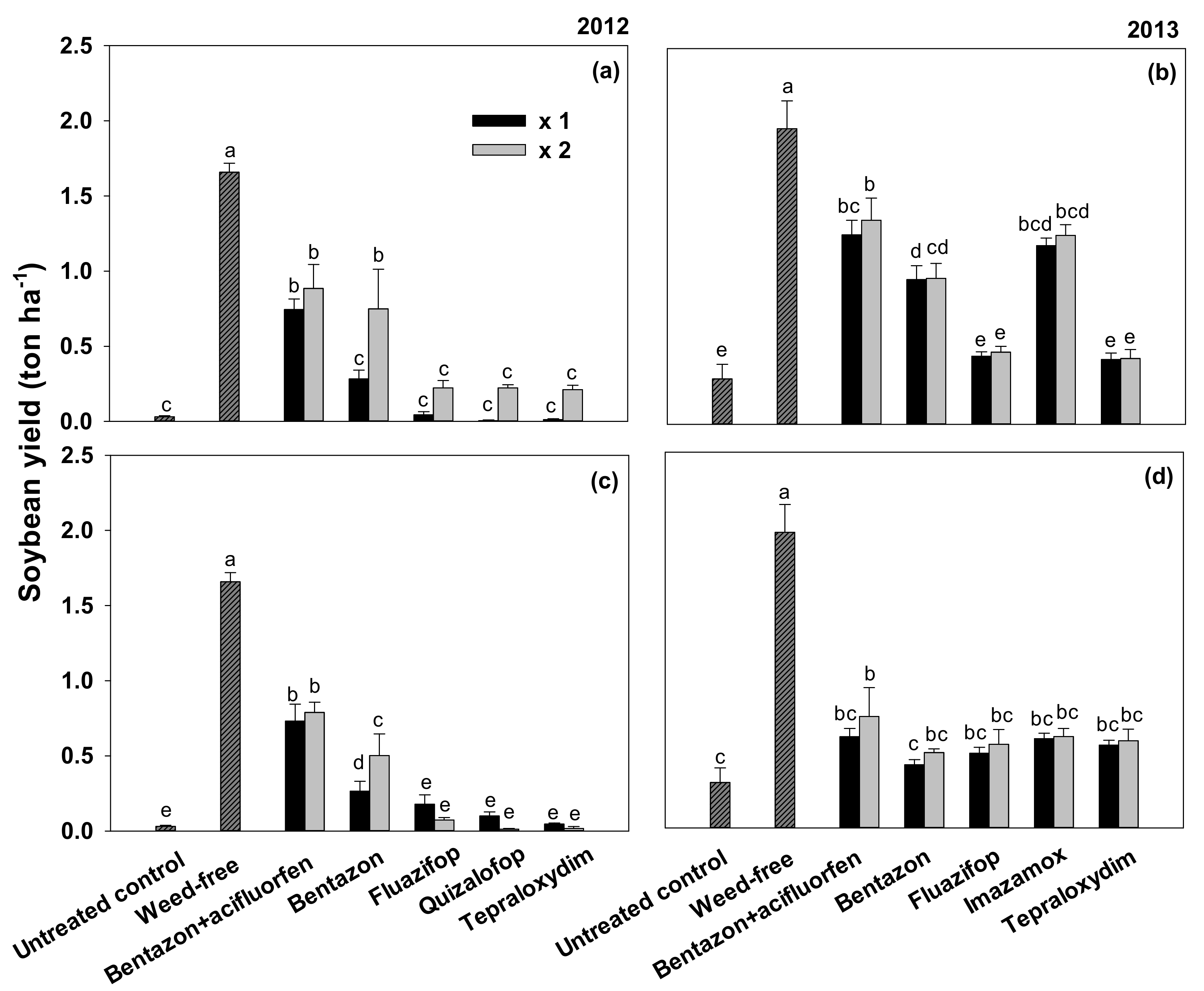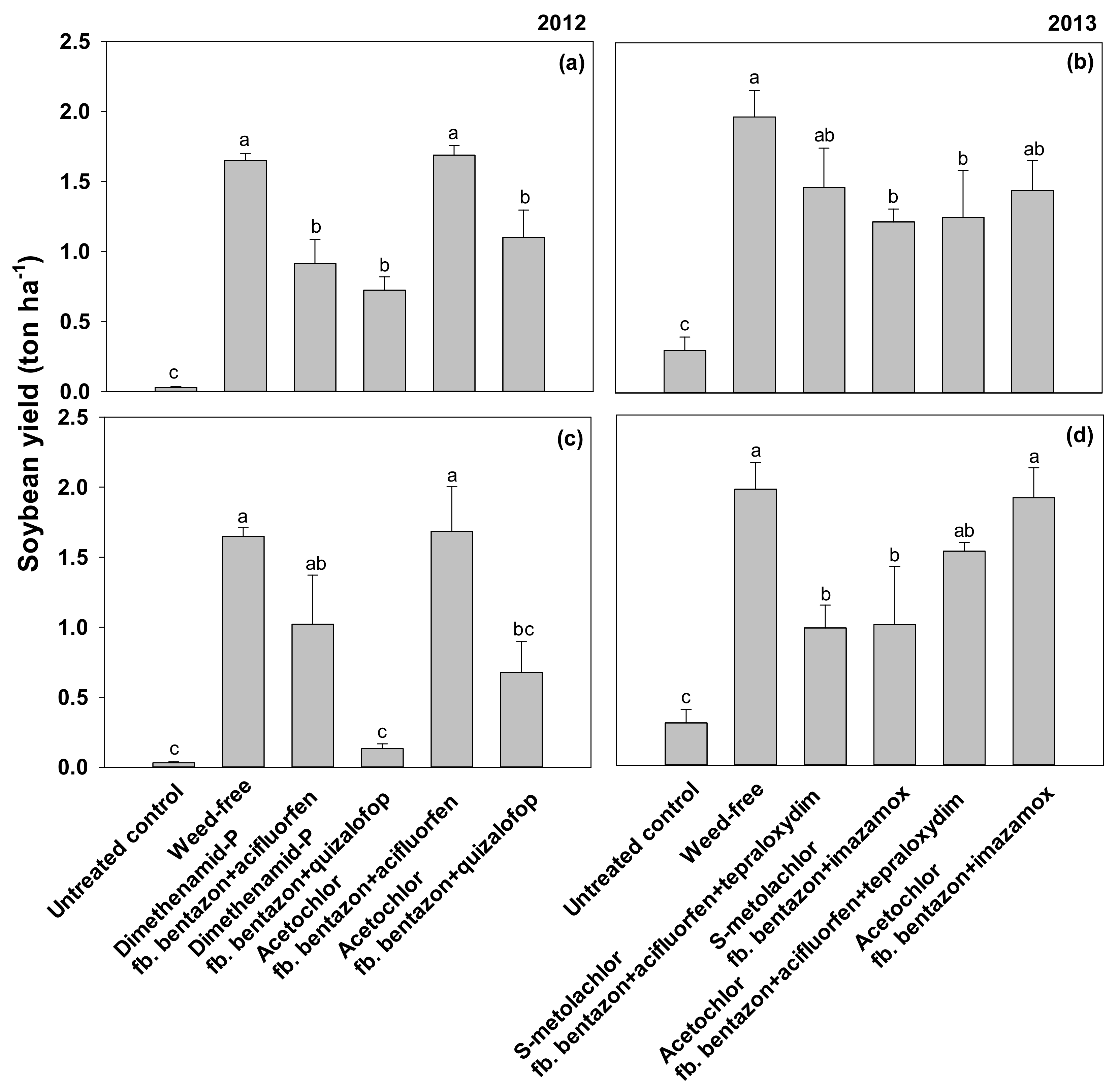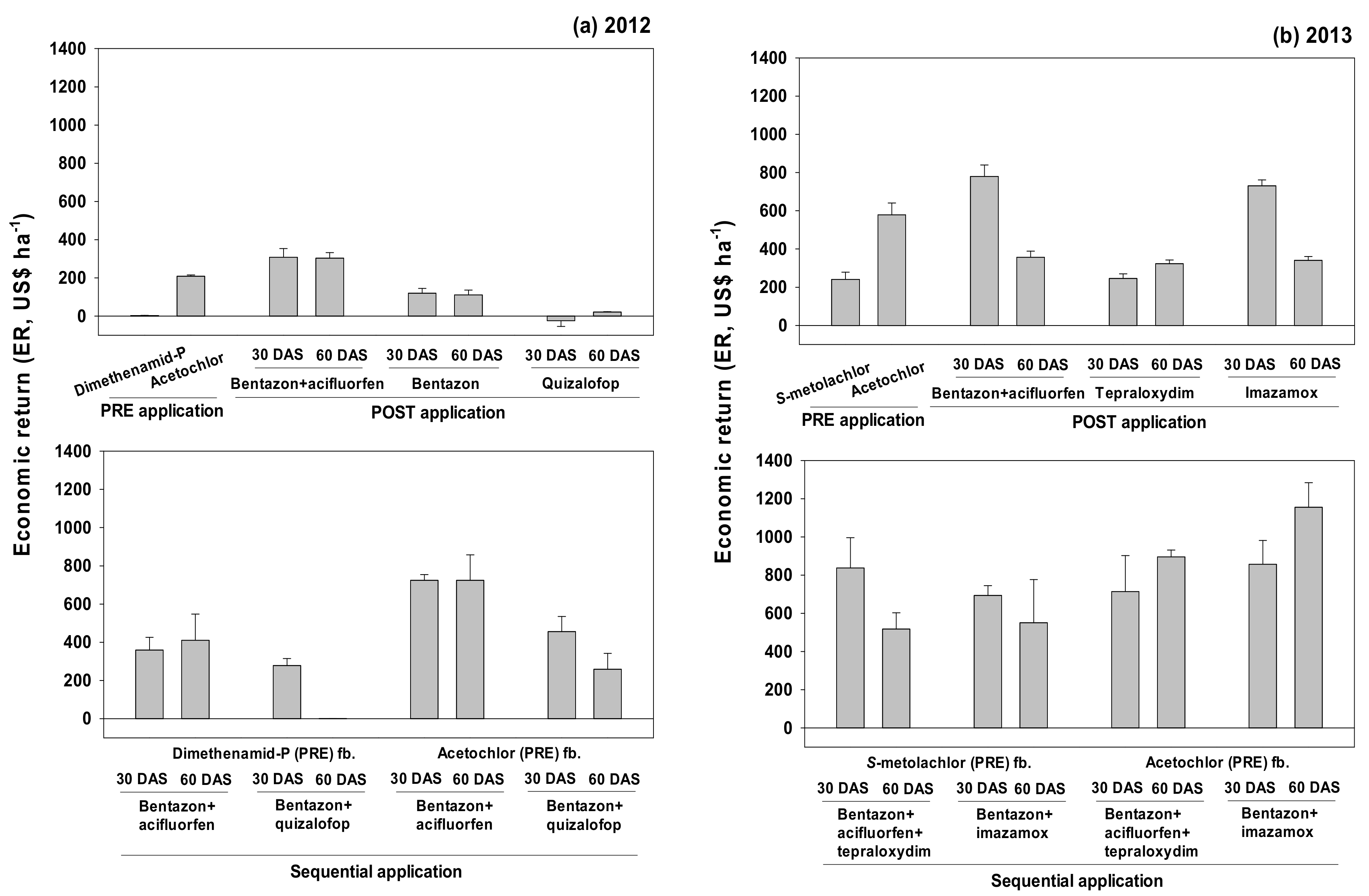Herbicide-Based Weed Management for Soybean Production in the Far Eastern Region of Russia
Abstract
1. Introduction
2. Materials and Methods
2.1. Experimental Site
2.2. Performance Test of Sole Application of PRE and POST Herbicides
2.3. Performance Test of Sequential Application of PRE and POST Herbicides
2.4. Economic Analysis for Herbicide-Based Weed Management
2.5. Statistical Analysis
3. Results
3.1. Performance of Sole Application of PRE Herbicides
3.2. Performance of Sole Application of POST Herbicides
3.3. Performance of Sequential Application of PRE and POST Herbicides
3.4. Economic Return for the Sequential PRE and POST Herbicide Application
4. Discussion
Supplementary Materials
Author Contributions
Funding
Conflicts of Interest
References
- Wax, L.M.; Pendleton, J.W. Effect of row spacing on weed control in soybeans. Weed Sci. 1968, 16, 462–465. [Google Scholar] [CrossRef]
- Yelverton, F.H.; Coble, H.D. Narrow row spacing and canopy formation reduces weed resurgence in soybeans (Glycine max). Weed Technol. 1991, 5, 169–174. [Google Scholar] [CrossRef]
- Hock, S.M.; Knezevic, S.Z.; Martin, A.R.; Lindquist, J.L. Soybean row spacing and weed emergence time influence weed competitiveness and competitive indices. Weed Sci. 2006, 54, 38–46. [Google Scholar] [CrossRef]
- Carey, J.B.; Defelice, M.S. Timing of chlorimuron and imazaquin application for weed control in no-till soybeans (Glycine max). Weed Sci. 1991, 39, 232–237. [Google Scholar] [CrossRef]
- Nelson, K.A.; Renner, K.A. Weed control in wide- and narrow-row soybean (Glycine max) with imazamox, imazethapyr, and CGA-277476 plus quizalofop. Weed Technol. 1998, 12, 137–144. [Google Scholar] [CrossRef]
- Harder, D.B.; Sprague, C.L.; Renner, K.A. Effect of soybean row width and population on weeds, crop yield, and economic return. Weed Technol. 2007, 21, 744–752. [Google Scholar] [CrossRef]
- Vivian, R.; Reis, A.; Kálnay, P.A.; Vargas, L.; Ferreira, A.C.C.; Mariani, F. Weed management in soybean—issues and practices. In Soybean—Pest Resistance; EL-Shemy, H.A., Ed.; InTech: Rijeka, Croatia, 2013; pp. 47–84. [Google Scholar]
- Lee, D.S. Korea’s agricultural production in the Russian Far East. Probl. Econ. Transit. 2018, 60, 307–324. [Google Scholar]
- Park, K.Y.; Kim, H.T.; Kang, S.T.; Han, W.Y.; Kim, Y.M.; Shin, S.H. Soybean production circumstance and its urgent problem in Primorsky. Korea Soybean Dig. 2015, 32, 1–10. [Google Scholar]
- Song, J.S.; Kim, J.W.; Im, J.H.; Lee, K.J.; Lee, B.W.; Kim, D.S. The effects of single- and multiple-weed interference on soybean yield in the Far Eastern region of Russia. Weed Sci. 2017, 65, 371–380. [Google Scholar] [CrossRef]
- Hager, A.; Renner, K. Common ragweed (Ambrosia artemisiifolia) control in soybean (Glycine max) with bentazon as influenced by imazethapyr or thifensulfuron tank-mixes. Weed Technol. 1994, 8, 766–771. [Google Scholar] [CrossRef]
- Leif, J.W.; Vollmer, J.L.; Hartberg, T.J.; Ballard, T.O. Growth and response of common ragweed (Ambrosia artemisiifolia) ecotypes to imazethapyr. Weed Technol. 2000, 14, 150–155. [Google Scholar] [CrossRef]
- Johnson, B.J. Effects of sequential herbicide treatments on weeds and soybeans. Weed Sci. 1971, 19, 695–700. [Google Scholar] [CrossRef]
- Anderson, J.M.; McWhorter, C.G. The economics of common cocklebur control in soybean production. Weed Sci. 1976, 24, 397–400. [Google Scholar] [CrossRef]
- Watts, J.R.; Murdock, E.C.; Stapleton, G.S.; Toler, J.E. Sicklepod (Senna obtusifolia) control in soybean (Glycine max) with single and sequential herbicide applications. Weed Technol. 1997, 11, 157–163. [Google Scholar] [CrossRef]
- Soltani, N.; Vyn, J.D.; Sikkema, P.H. Control of common waterhemp (Amaranthus tuberculatus var. rudis) in corn and soybean with sequential herbicide applications. Can. J. Plant Sci. 2009, 89, 127–132. [Google Scholar] [CrossRef]
- SAS. SAS/STAT Systems for Windows v. 9.3; SAS Institute: Cary, NC, USA, 2011. [Google Scholar]
- Bàrberi, P.; Cozzani, A.; Macchia, M.; Bonari, E. Size and composition of the weed seedbank under different management systems for continuous maize cropping. Weed Res. 1998, 38, 319–334. [Google Scholar] [CrossRef]
- Kim, D.S.; Brain, P.; Marshall, E.J.P.; Caseley, J.C. Modelling herbicide dose and weed density effects on crop:weed competition. Weed Res. 2002, 42, 1–13. [Google Scholar] [CrossRef]
- Klingman, T.E.; King, C.A.; Oliver, L.R. Effect of application rate, weed species, and weed stage of growth on imazethapyr activity. Weed Sci. 1992, 40, 227–232. [Google Scholar] [CrossRef]
- Rosales-Robels, E.; Chandler, J.M.; Senseman, S.A.; Prostko, E.P. Influence of growth stage and herbicide rate on postemergence johnsongrass (Sorghum halepense) control. Weed Technol. 1999, 13, 525–529. [Google Scholar] [CrossRef]
- Hammerton, J.L. Environmental factors and susceptibility to herbicides. Weeds 1967, 15, 330–336. [Google Scholar] [CrossRef]
- Kim, D.S.; Marshall, E.J.P.; Caseley, J.C.; Brain, P. Modelling interactions between herbicide dose and multiple weed species interference in crop-weed competition. Weed Res. 2006, 46, 175–184. [Google Scholar] [CrossRef]
- Johnson, G.A.; Hoverstad, T.R. Effect of row spacing and herbicide application timing on weed control and grain yield in corn (Zea mays). Weed Technol. 2002, 16, 548–553. [Google Scholar] [CrossRef]
- Song, J.S.; Lim, S.H.; Lim, Y.; Nah, G.; Lee, D.K.; Kim, D.S. Herbicide-based weed management in Miscanthus sacchariflorus. Bioenergy Res. 2016, 9, 326–334. [Google Scholar] [CrossRef]
- Vail, G.D.; Oliver, L.R. Barnyardgrass (Echinochloa crus-galli) interference in soybeans (Glycine max). Weed Technol. 1993, 7, 220–225. [Google Scholar] [CrossRef]
- Cowbrough, M.J.; Brown, R.B.; Tardif, F.J. Impact of common ragweed (Ambrosia artemisiifolia) aggregation on economic thresholds in soybean. Weed Sci. 2003, 51, 947–954. [Google Scholar] [CrossRef]
- Sweat, J.K.; Horak, M.J.; Peterson, D.E.; Lloyd, R.W.; Boyer, J.E. Herbicide efficacy on four Amaranthus species in soybean (Glycine max). Weed Technol. 1998, 12, 315–321. [Google Scholar] [CrossRef]
- Han, J.; Liu, H.; Guo, P.; Hao, C. Weed control in summer-sown soybeans with flumioxazin plus acetochlor and flumiclorac-pentyl plus clethodim. Weed Biol. Manag. 2002, 2, 120–122. [Google Scholar] [CrossRef]
- Pornprom, T.; Sukcharoenvipharat, W.; Sansiriphun, D. Weed control with pre-emergence herbicides in vegetable soybean (Glycine max L. Merrill). Crop Prot. 2010, 29, 684–690. [Google Scholar] [CrossRef]
- Mickelson, J.A.; Harvey, R.G. Woolly cupgrass (Eriochloa villosa) management in corn (Zea mays) by sequential herbicide applications and cultivation. Weed Technol. 2000, 14, 502–510. [Google Scholar] [CrossRef]
- EU Pesticides Database. Available online: https://ec.europa.eu/food/plant/pesticides/eu-pesticides-database (accessed on 13 November 2020).




| Herbicides | Recommended Dose (g a.i. ha−1) | Application Time (Days after Sowing) |
|---|---|---|
| PRE herbicides | ||
| Acetochlor | 900 | 0 |
| Dimethenamid-P | 720 | 0 |
| Ethalfluralin | 1050 | 0 |
| Pendimethalin | 951 | 0 |
| S-metolachlor | 750 | 0 |
| POST herbicides | ||
| Bentazon+acifluorfen | 416 + 208 | 30, 60 |
| Bentazon | 560 | 30, 60 |
| Fluazifop-p-butyl | 175 | 30, 60 |
| Quizalofop-p-tefuryl | 120 | 30, 60 |
| Tepraloxydim | 90 | 30, 60 |
| Imazamox | 40 | 30, 60 |
Publisher’s Note: MDPI stays neutral with regard to jurisdictional claims in published maps and institutional affiliations. |
© 2020 by the authors. Licensee MDPI, Basel, Switzerland. This article is an open access article distributed under the terms and conditions of the Creative Commons Attribution (CC BY) license (http://creativecommons.org/licenses/by/4.0/).
Share and Cite
Song, J.-S.; Chung, J.-H.; Lee, K.J.; Kwon, J.; Kim, J.-W.; Im, J.-H.; Kim, D.-S. Herbicide-Based Weed Management for Soybean Production in the Far Eastern Region of Russia. Agronomy 2020, 10, 1823. https://doi.org/10.3390/agronomy10111823
Song J-S, Chung J-H, Lee KJ, Kwon J, Kim J-W, Im J-H, Kim D-S. Herbicide-Based Weed Management for Soybean Production in the Far Eastern Region of Russia. Agronomy. 2020; 10(11):1823. https://doi.org/10.3390/agronomy10111823
Chicago/Turabian StyleSong, Jong-Seok, Ji-Hoon Chung, Kyu Jong Lee, Jihyung Kwon, Jin-Won Kim, Ji-Hoon Im, and Do-Soon Kim. 2020. "Herbicide-Based Weed Management for Soybean Production in the Far Eastern Region of Russia" Agronomy 10, no. 11: 1823. https://doi.org/10.3390/agronomy10111823
APA StyleSong, J.-S., Chung, J.-H., Lee, K. J., Kwon, J., Kim, J.-W., Im, J.-H., & Kim, D.-S. (2020). Herbicide-Based Weed Management for Soybean Production in the Far Eastern Region of Russia. Agronomy, 10(11), 1823. https://doi.org/10.3390/agronomy10111823





